Analysis of the Surface/Interface Damage Evolution Behavior of a Coating–Substrate System under Heavy-Load Elastohydrodynamic Lubrication
Abstract
1. Introduction
2. Numerical Model Description
2.1. EHL Model
2.2. Cohesive Zone Model
3. Numerical Calculation
4. Results and Discussion
4.1. EHL Response
4.2. Equivalent Stress Analysis
4.3. Failure Prediction
4.4. Damage Evolution
5. Conclusions
- On the whole, when the load was constant, the elastic modulus of the thin coating (on the steel substrate) had little effect on the oil film pressure distribution. Locally, with the increase of the coating elastic modulus, the oil center pressure increased, and the secondary pressure peak became more significant due to the change in coating stiffness. This conclusion is consistent with the results of the analysis of the uncoupled CZM on interface.
- Under the same external load, the maximum equivalent stress of the soft coating system was smaller than that of the hard coating system, which was located on the subsurface of the system, while the maximum equivalent stress of the hard coating system was distributed on the surface of the coating and the interface. This was because of the stiffness difference between the coating and substrate from the point of view of mechanics.
- When the thin coating and steel gear substrate system was in service under heavy-load EHL, the shear stress in the coating and shear stress on the interface were the main causes of the coating cracking and interfacial delamination, respectively, which appeared near the secondary pressure peak and all show sliding type failure. The reason is that the geometric dimensions of the contact solids varied greatly, which resulted in shear stress in the dangerous section being much larger than the tensile stress.
- The surface/interface damage evolution behavior of the coating–substrate system was analyzed visually by embedding cohesive zone elements. In light of the energy transfer theory, the interfacial delamination increased the crack failure probability of the coating and vice versa.
Author Contributions
Funding
Acknowledgments
Conflicts of Interest
References
- Liu, H.; Liu, H.; Zhu, C.; Zhou, Y. A Review on Micropitting Studies of Steel Gears. Coatings 2019, 9, 42. [Google Scholar] [CrossRef]
- Hieke, A.; Lieberman, V.; van der Kolk, G.J. Hard Coatings and Coating Processes for the Automotive Industry. In Coating Technology for Vehicle Applications; Cha, S.C., Erdemir, A., Eds.; Springer International Publishing: Cham, Switzerland, 2015; pp. 133–148. [Google Scholar]
- Xiao, Y.; Shi, W.; Li, L.; Ye, X. Fatigue performance of cylindrical gearing with DLC coatings. In Proceedings of the International Gear Conference 2014, Lyon, France, 26–28 August 2014; Velex, P., Ed.; Chandos Publishing: Oxford, UK, 2014; pp. 516–522. [Google Scholar]
- Liu, Y.; Chen, W.W.; Zhu, D.; Liu, S.; Wang, Q.J. An Elastohydrodynamic Lubrication Model for Coated Surfaces in Point Contacts. J. Tribol. 2007, 129, 509–516. [Google Scholar] [CrossRef]
- Wang, Z.-J.; Wang, W.-Z.; Wang, H.; Hu, Y.-Z. Stress Analysis on Layered Materials in Point Elastohydrodynamic-Lubricated Contacts. Tribol. Lett. 2009, 35, 229–244. [Google Scholar] [CrossRef]
- Liu, H.; Zhu, C.; Wang, Z.; Xu, X.; Tang, J. Investigation on the effect of coating properties on lubrication of a coated spur gear pair. Proc. Inst. Mech. Eng. Part J J. Eng. Tribol. 2018, 232, 277–290. [Google Scholar] [CrossRef]
- Xiao, Y.; Shi, W.; Luo, J. Mechanical responses of coated solids in elastohydrodynamically lubricated line contacts. Int. J. Surf. Sci. Eng. 2017, 11, 450. [Google Scholar] [CrossRef]
- Habchi, W. A numerical model for the solution of thermal elastohydrodynamic lubrication in coated circular contacts. Tribol. Int. 2014, 73, 57–68. [Google Scholar] [CrossRef]
- Alakhramsing, S.S.; De Rooij, M.B.; Schipper, D.J.; Van Drogen, M. Elastohydrodynamic lubrication of coated finite line contacts. Proc. Inst. Mech. Eng. Part J J. Eng. Tribol. 2017, 232, 1077–1092. [Google Scholar] [CrossRef]
- Ziegltrum, A.; Lohner, T.; Stahl, K. TEHL Simulation on the Influence of Lubricants on the Frictional Losses of DLC Coated Gears. Lubricants 2018, 6, 17. [Google Scholar] [CrossRef]
- Lofaj, F.; Németh, D. Multiple cohesive cracking during nanoindentation in a hard W-C coating/steel substrate system by FEM. J. Eur. Ceram. Soc. 2017, 37, 4379–4388. [Google Scholar] [CrossRef]
- Lee, C.-C. Overview of interfacial fracture energy predictions for stacked thin films using a four-point bending framework. Surf. Coat. Technol. 2013, 237, 333–340. [Google Scholar] [CrossRef]
- Hu, J.; Chou, Y.; Thompson, R. Cohesive zone effects on coating failure evaluations of diamond-coated tools. Surf. Coat. Technol. 2008, 203, 730–735. [Google Scholar] [CrossRef]
- Tilbrook, M.T.; Paton, D.J.; Xie, Z.; Hoffman, M. Microstructural effects on indentation failure mechanisms in TiN coatings: Finite element simulations. Acta Mater. 2007, 55, 2489–2501. [Google Scholar] [CrossRef]
- Lin, P.; Shen, F.; Yeo, A.; Liu, B.; Xue, M.; Xu, H.; Zhou, K. Characterization of interfacial delamination in multi-layered integrated circuit packaging. Surf. Coat. Technol. 2017, 320, 349–356. [Google Scholar] [CrossRef]
- Xiao, Y.; Shi, W.; Wan, Q.; Luo, J. Evaluation of failure properties of a DLC/steel system using combined nanoindentation and finite element approach. Diam. Relat. Mater. 2019, 93, 159–167. [Google Scholar] [CrossRef]
- Ning, J.; Liang, S.Y. Inverse identification of Johnson-Cook material constants based on modified chip formation model and iterative gradient search using temperature and force measurements. Int. J. Adv. Manuf. Technol. 2019, 102, 2865–2876. [Google Scholar] [CrossRef]
- Lohner, T.; Ziegltrum, A.; Stemplinger, J.-P.; Stahl, K. Engineering Software Solution for Thermal Elastohydrodynamic Lubrication Using Multiphysics Software. Adv. Tribol. 2016, 2016, 1–13. [Google Scholar] [CrossRef]
- Roelands, C.J.A. Correlational Aspects of the Viscosity-Temperature-Pressure Relationship of Lubricating Oils; Delft University of Technology (TU Delft): Delft, The Netherlands, 1966. [Google Scholar]
- Dowson, D.; Higginson, G.R. Elasto-Hydrodynamic Lubrication: The Fundamentals of Roller and Gear Lubrication; Pergamon Press: Oxford, UK, 1966; Volume 23. [Google Scholar]
- Habchi, W. A Full-System Finite Element Approach to Elastohydrodynamic Lubrication Problems: Application to Ultra-Low-Viscosity Fluids; Laboratoire de Recherche, Laboratoire de Mécanique des Contacts et des Structures, LaMCoS, INSA–Lyon: Villeurbanne, France, 2008. [Google Scholar]
- Rezaei, S.; Wulfinghoff, S.; Reese, S. Prediction of fracture and damage in micro/nano coating systems using cohesive zone elements. Int. J. Solids Struct. 2017, 121, 62–74. [Google Scholar] [CrossRef]
- Ottosen, N.S.; Ristinmaa, M.; Mosler, J.; Mosler, J. Fundamental physical principles and cohesive zone models at finite displacements—Limitations and possibilities. Int. J. Solids Struct. 2015, 53, 70–79. [Google Scholar] [CrossRef]
- Rezaei, S.; Jaworek, D.; Mianroodi, J.R.; Wulfinghoff, S.; Reese, S. Atomistically motivated interface model to account for coupled plasticity and damage at grain boundaries. J. Mech. Phys. Solids 2019, 124, 325–349. [Google Scholar] [CrossRef]
- Zhu, W.; Yang, L.; Guo, J.; Zhou, Y.; Lu, C. Determination of interfacial adhesion energies of thermal barrier coatings by compression test combined with a cohesive zone finite element model. Int. J. Plast. 2015, 64, 76–87. [Google Scholar] [CrossRef]
- Li, X.; Liang, L.; Xie, J.; Chen, L.; Wei, Y. Thickness-dependent fracture characteristics of ceramic coatings bonded on the alloy substrates. Surf. Coat. Technol. 2014, 258, 1039–1047. [Google Scholar] [CrossRef]
- Camanho, P.P.; Dávila, C.G. Mixed-Mode Decohesion Finite Elements for the Simulation of Delamination in Composite Materials; NASA: Hanover, MD, USA, 2002.
- Moorthy, V.; Shaw, B. An observation on the initiation of micro-pitting damage in as-ground and coated gears during contact fatigue. Wear 2013, 297, 878–884. [Google Scholar] [CrossRef]
- Wang, J.; Sugimura, Y.; Evans, A.; Tredway, W. The mechanical performance of DLC films on steel substrates. Thin Solid Films 1998, 325, 163–174. [Google Scholar] [CrossRef]
- Xie, Z.H.; Singh, R.; Bendavid, A.; Martin, P.J.; Munroe, P.R.; Hoffman, M. Contact damage evolution in a diamond-like carbon (DLC) coating on a stainless steel substrate. Thin Solid Films 2007, 515, 3196–3201. [Google Scholar] [CrossRef]
- Ogwu, A.; Coyle, T.; Okpalugo, T.; Kearney, P.; Maguire, P.; McLaughlin, J. The influence of biological fluids on crack spacing distribution in Si-DLC films on steel substrates. Acta Mater. 2003, 51, 3455–3465. [Google Scholar] [CrossRef]
- Xiao, Y.; Shi, W.; Jing, L. Indentation for evaluating cracking and delamination of thin coatings using finite element analysis. Vacuum 2015, 122, 17–30. [Google Scholar] [CrossRef]
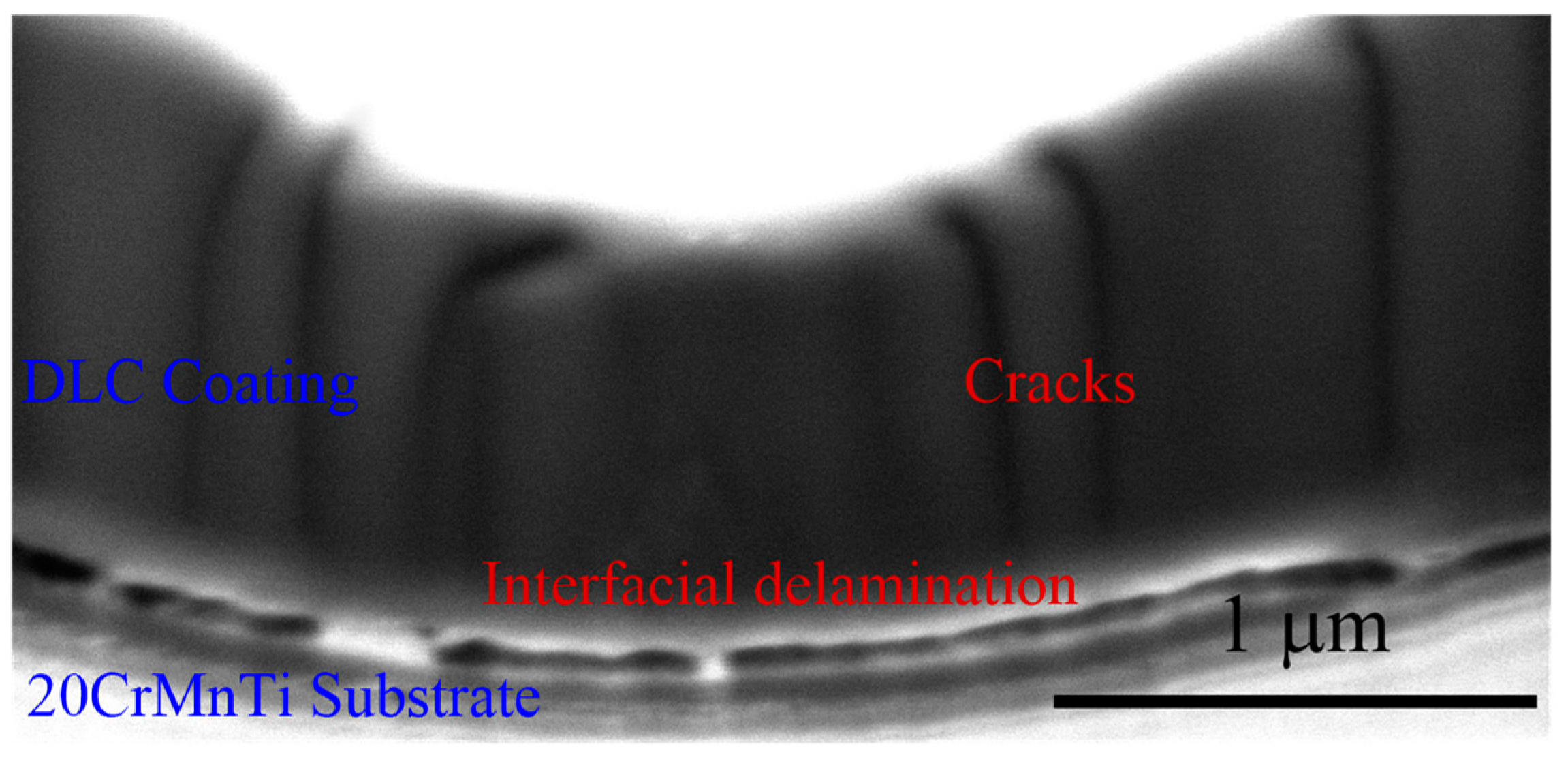
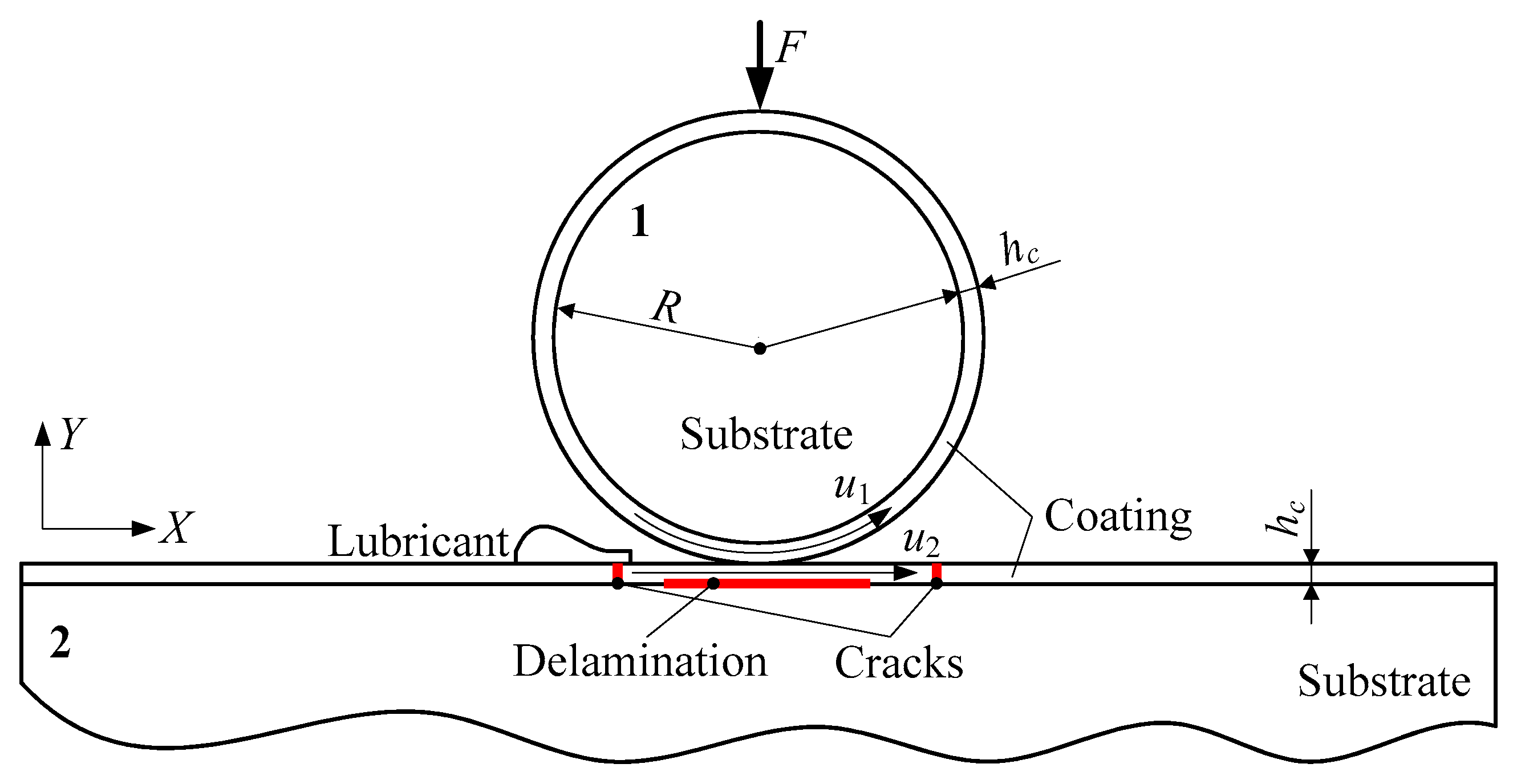
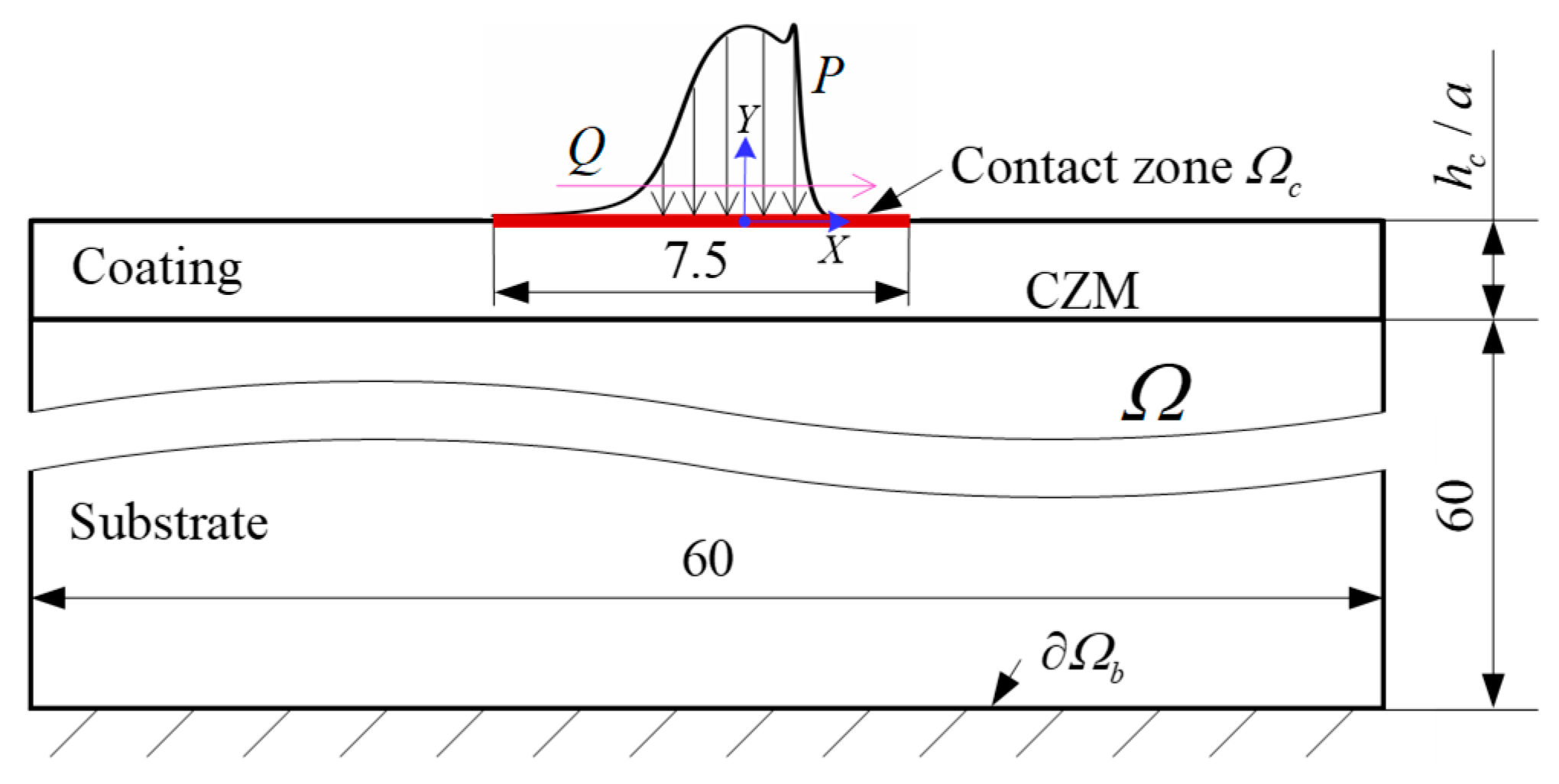
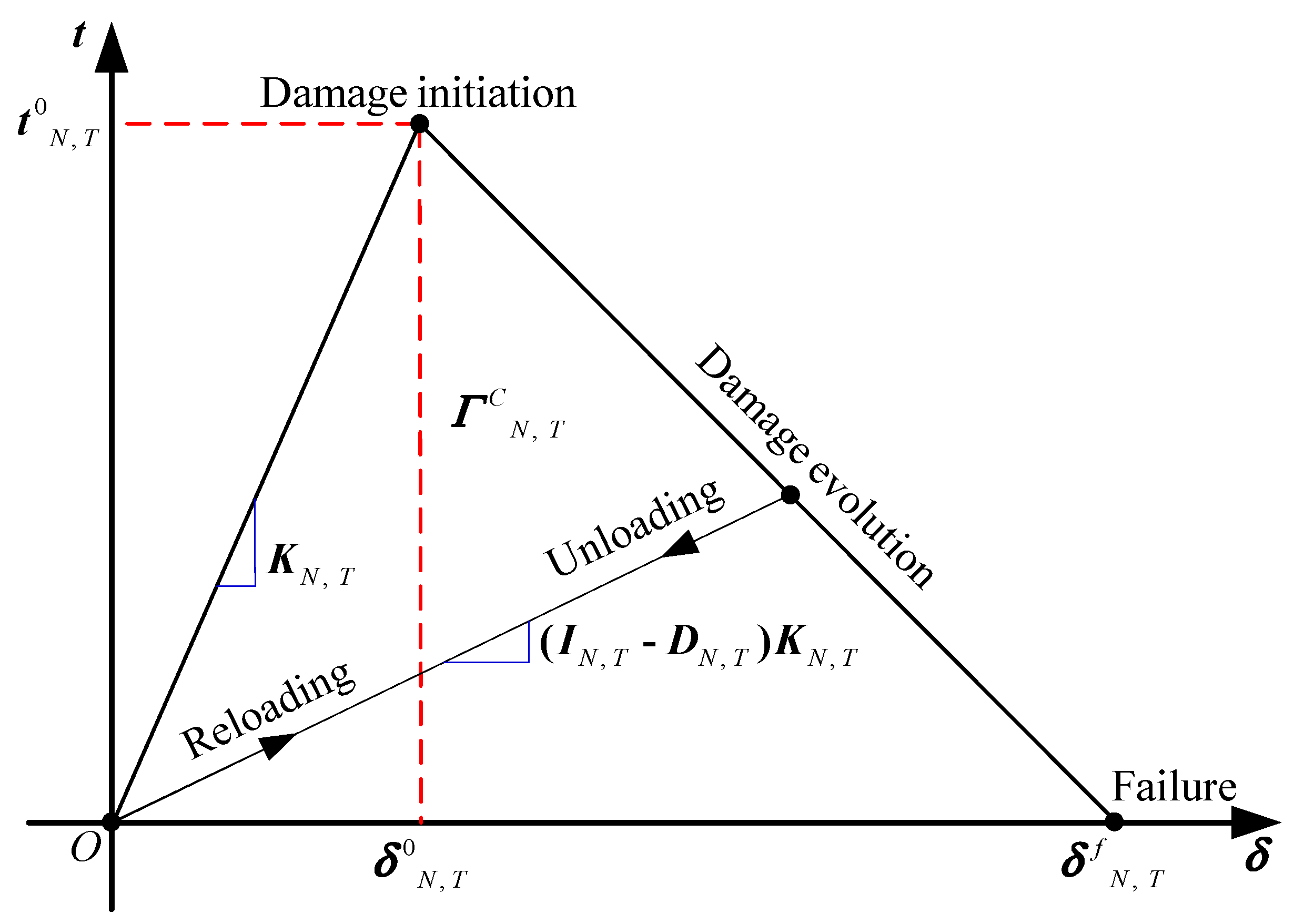
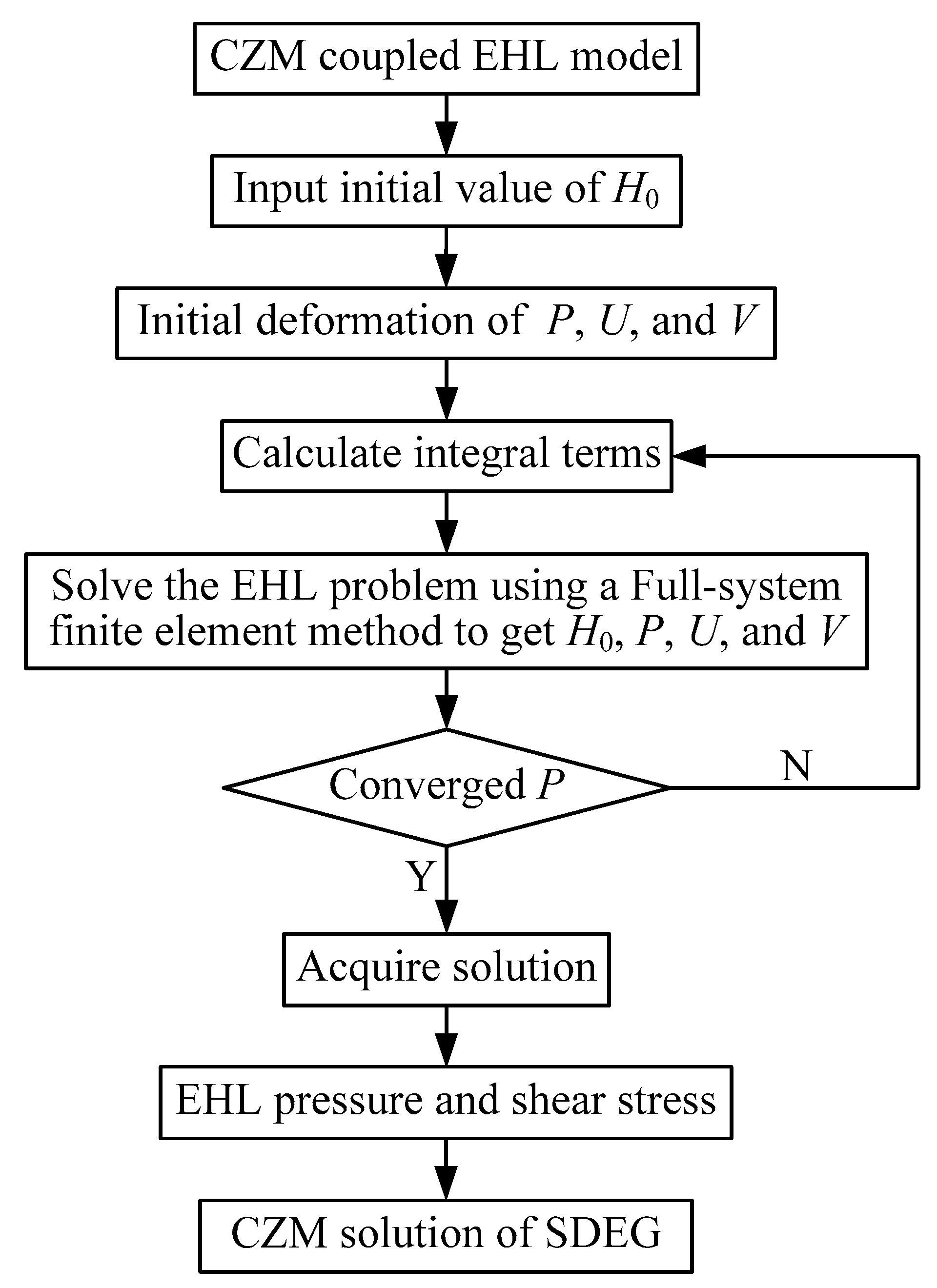
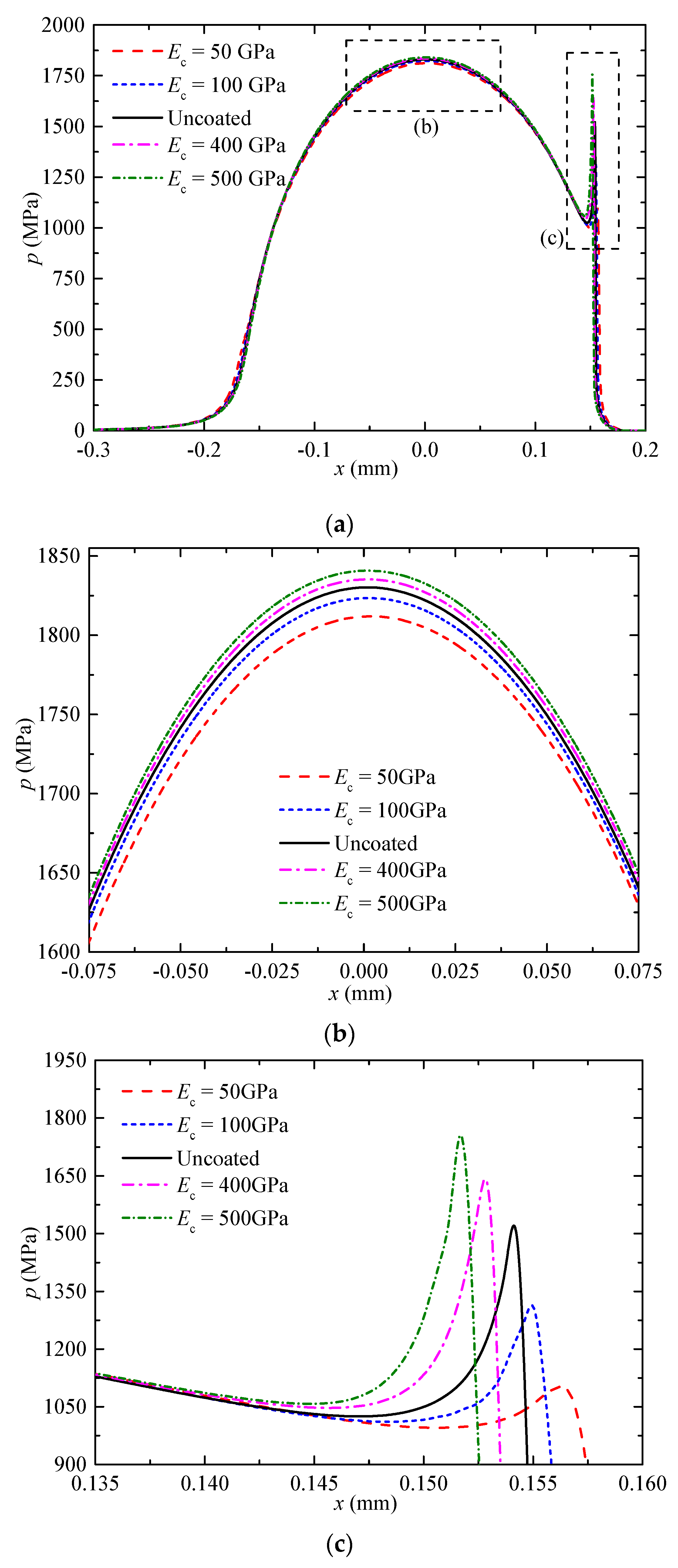
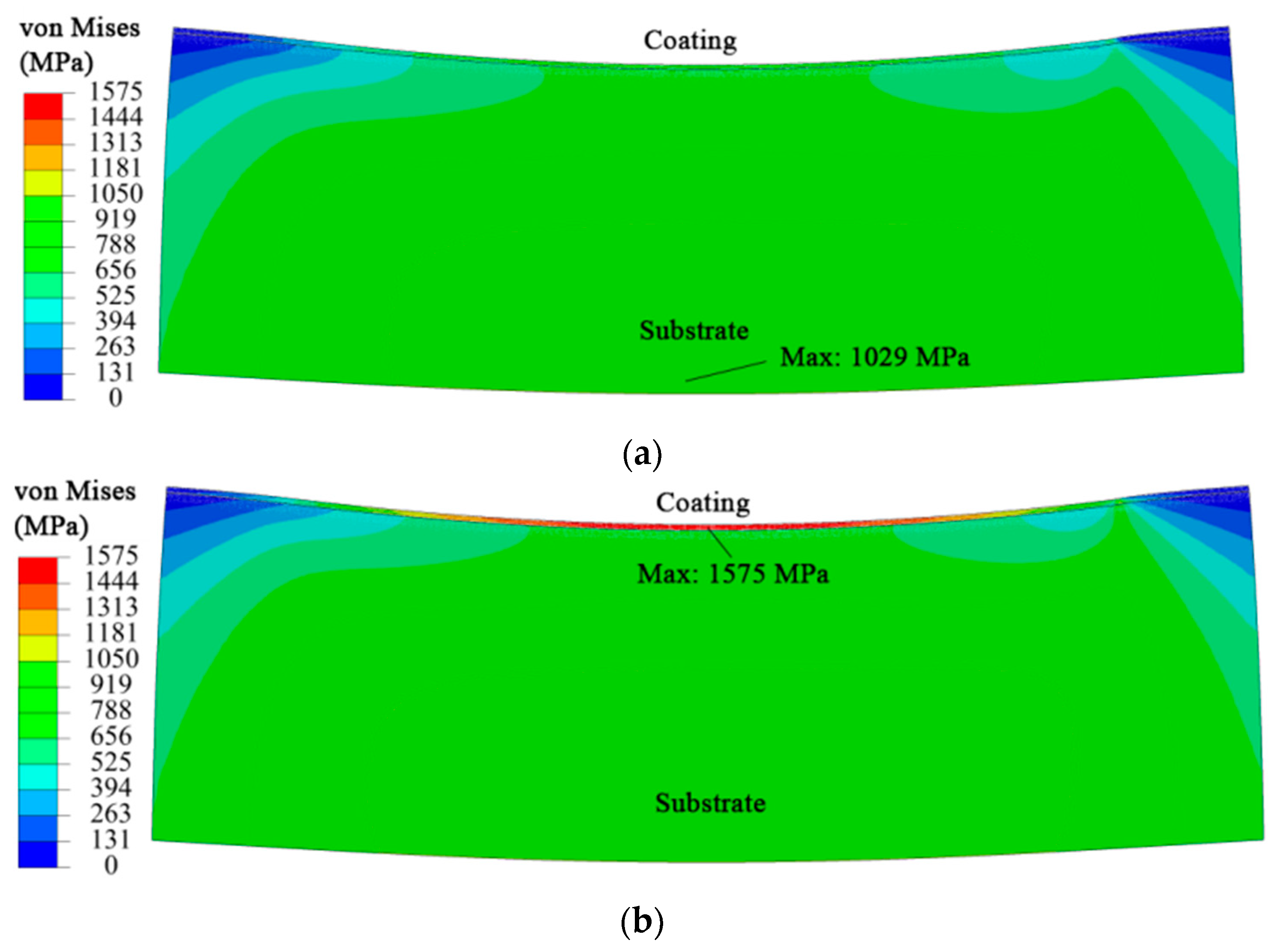
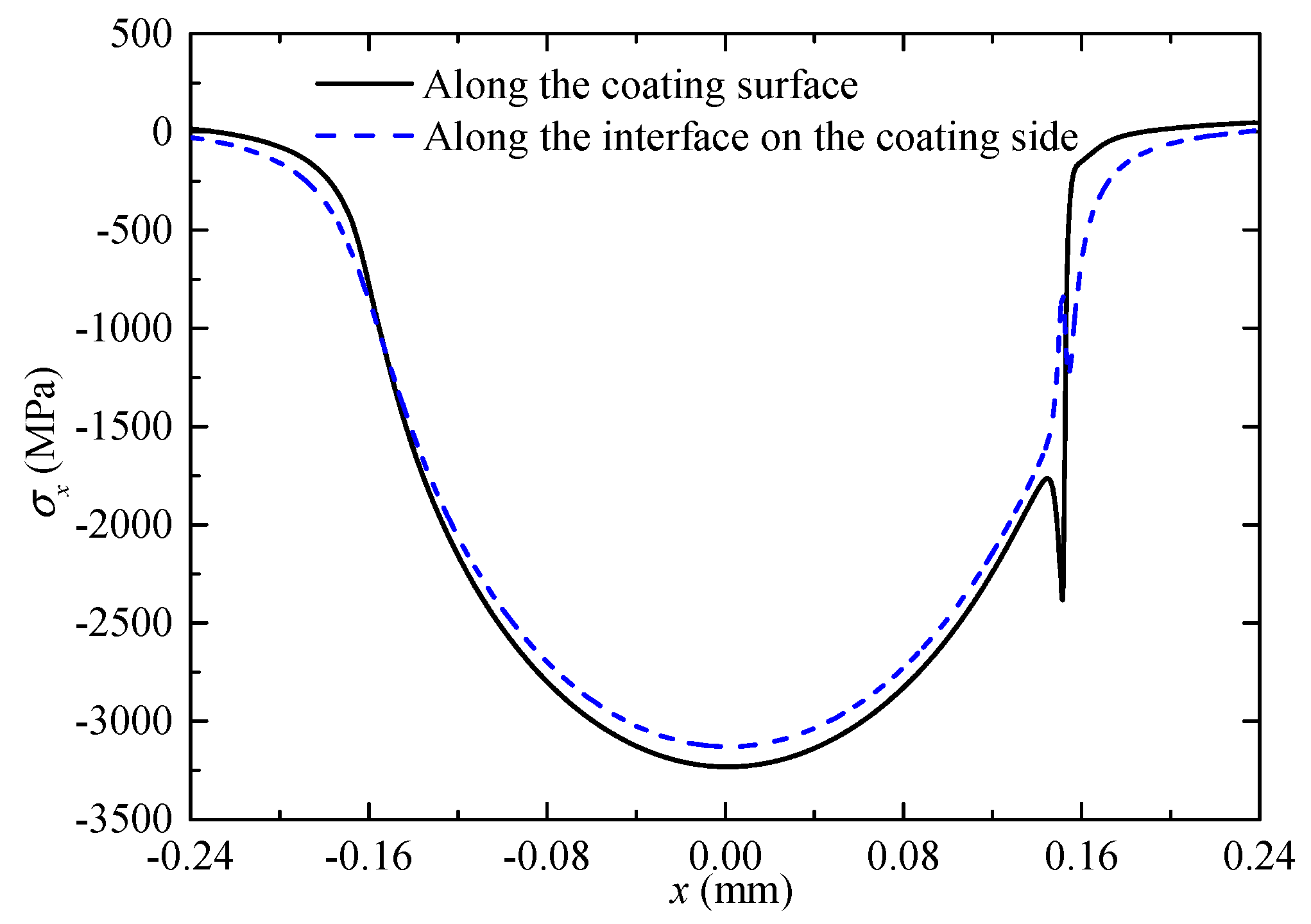


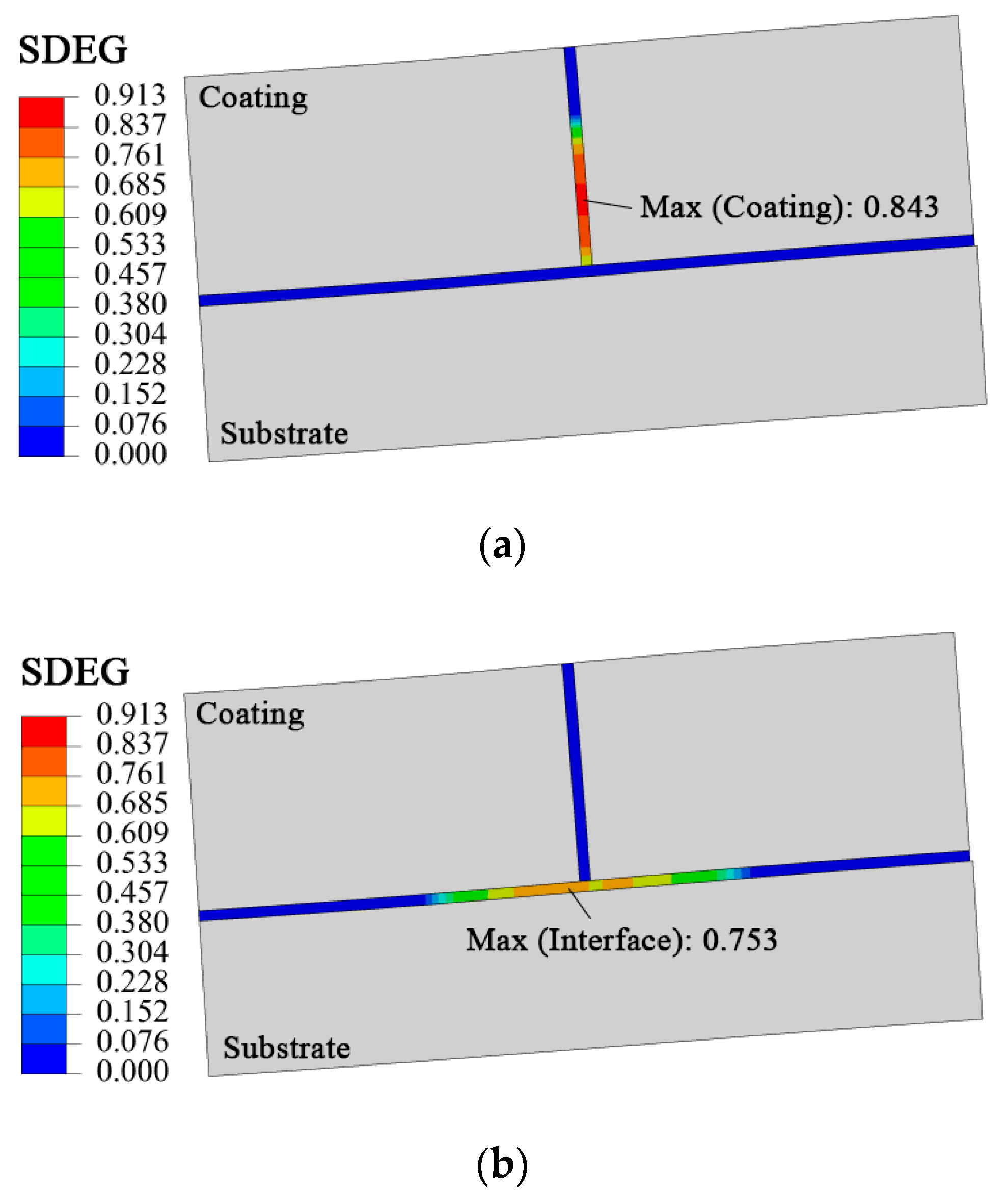
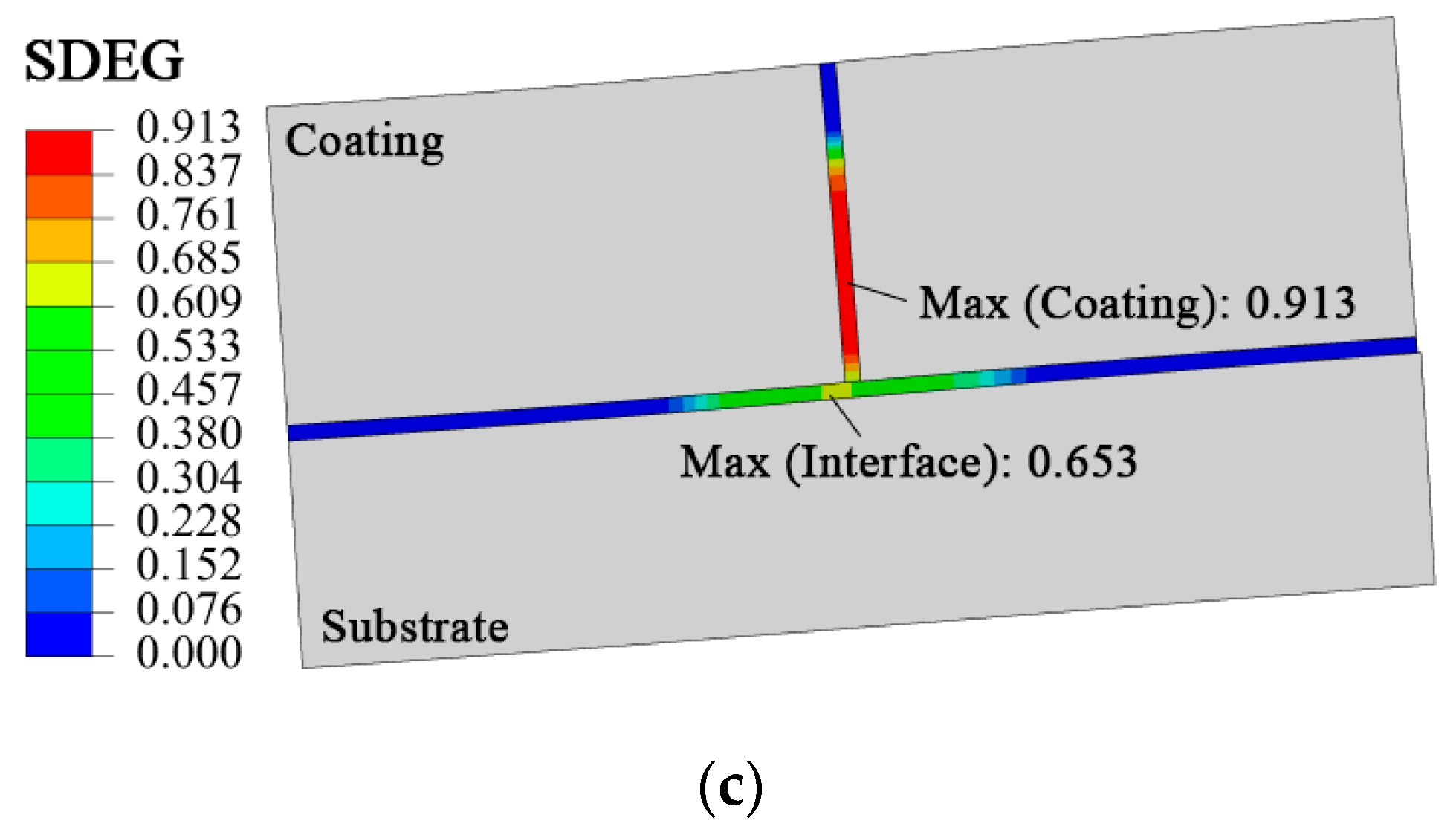
| Geometric Parameters | ||
|---|---|---|
| Radius R (m) | 5 × 10−3 | |
| Coating thickness hc (μm) | 2 | |
| Material properties | ||
| Elastic modulus | Substrate (GPa) | 200 |
| Coating (GPa) | 50, 100, 400, 500 | |
| Poisson’s ratio | Substrate | 0.3 |
| Coating | 0.3 | |
| Operating conditions | ||
| Maximum Hertzian pressure (uncoated) (MPa) | 1841 | |
| Hertzian half-width (uncoated) a (m) | 1.675 × 10−4 | |
| Surface velocity of body 1 u1 (m/s) | 5 | |
| Surface velocity of body 2 u2 (m/s) | 3 | |
| Lubricant properties | ||
| Ambient density of lubricant (kg/m3) | 870 | |
| Ambient viscosity of lubricant (Pa·s) | 0.04 | |
| Viscosity–pressure coefficient (Pa-1) | 2.2 × 10−8 | |
| Eyring stress (MPa) | 10 | |
© 2019 by the authors. Licensee MDPI, Basel, Switzerland. This article is an open access article distributed under the terms and conditions of the Creative Commons Attribution (CC BY) license (http://creativecommons.org/licenses/by/4.0/).
Share and Cite
Xiao, Y.; Zou, M.; Shi, W.; Kang, M. Analysis of the Surface/Interface Damage Evolution Behavior of a Coating–Substrate System under Heavy-Load Elastohydrodynamic Lubrication. Coatings 2019, 9, 642. https://doi.org/10.3390/coatings9100642
Xiao Y, Zou M, Shi W, Kang M. Analysis of the Surface/Interface Damage Evolution Behavior of a Coating–Substrate System under Heavy-Load Elastohydrodynamic Lubrication. Coatings. 2019; 9(10):642. https://doi.org/10.3390/coatings9100642
Chicago/Turabian StyleXiao, Yangyi, Mengjie Zou, Wankai Shi, and Minglin Kang. 2019. "Analysis of the Surface/Interface Damage Evolution Behavior of a Coating–Substrate System under Heavy-Load Elastohydrodynamic Lubrication" Coatings 9, no. 10: 642. https://doi.org/10.3390/coatings9100642
APA StyleXiao, Y., Zou, M., Shi, W., & Kang, M. (2019). Analysis of the Surface/Interface Damage Evolution Behavior of a Coating–Substrate System under Heavy-Load Elastohydrodynamic Lubrication. Coatings, 9(10), 642. https://doi.org/10.3390/coatings9100642





